2009 Hyundai Accent change time
[x] Cancel search: change timePage 1 of 232
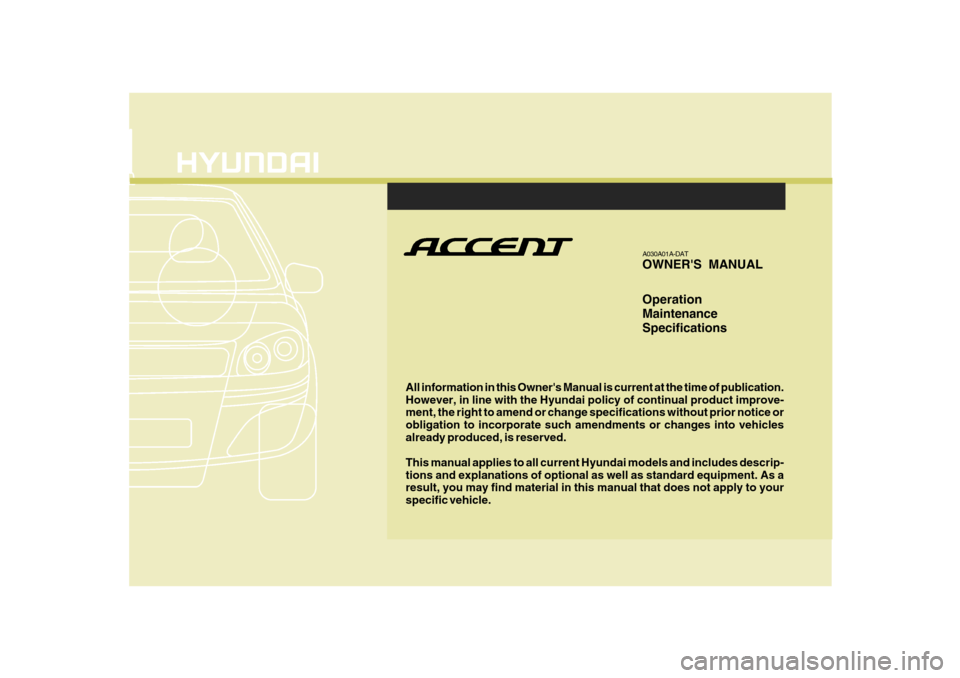
All information in this Owner's Manual is current at the time of publication. However, in line with the Hyundai policy of continual product improve- ment, the right to amend or change specifications without prior notice or obligation to incorporate such amendments or changes into vehiclesalready produced, is reserved. This manual applies to all current Hyundai models and includes descrip- tions and explanations of optional as well as standard equipment. As a result, you may find material in this manual that does not apply to your specific vehicle.
A030A01A-DAT OWNER'S MANUAL Operation MaintenanceSpecifications
Page 66 of 232
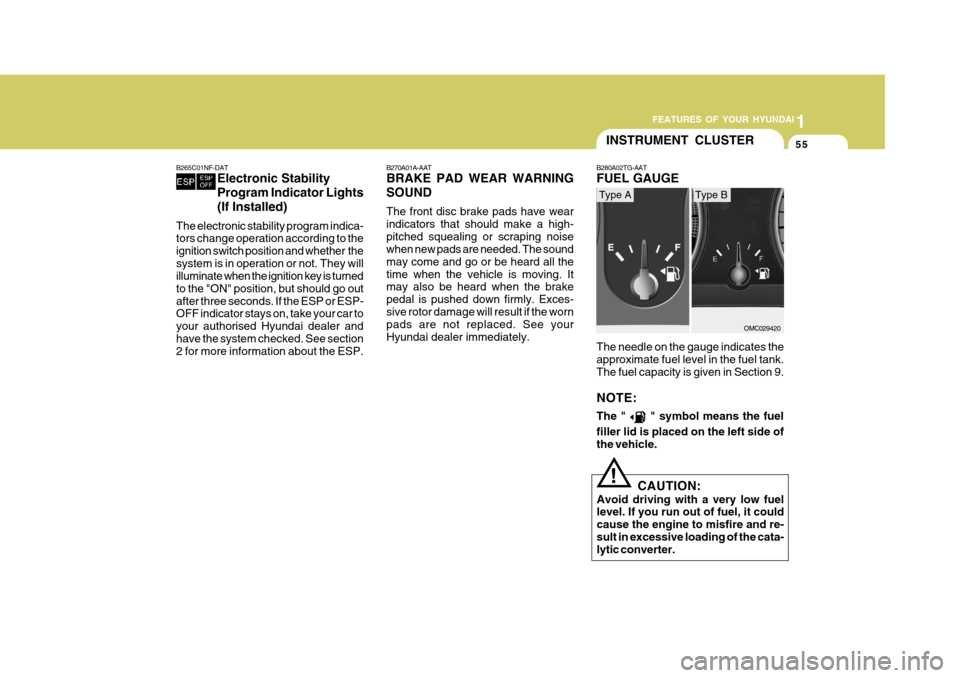
1
FEATURES OF YOUR HYUNDAI
55INSTRUMENT CLUSTER
The needle on the gauge indicates the approximate fuel level in the fuel tank. The fuel capacity is given in Section 9. NOTE: The "
" symbol means the fuel
filler lid is placed on the left side of the vehicle.
B280A02TG-AAT FUEL GAUGE
OMC029420
Type AType B
B270A01A-AAT BRAKE PAD WEAR WARNING SOUND The front disc brake pads have wear indicators that should make a high-pitched squealing or scraping noise when new pads are needed. The sound may come and go or be heard all thetime when the vehicle is moving. It may also be heard when the brake pedal is pushed down firmly. Exces-sive rotor damage will result if the worn pads are not replaced. See your Hyundai dealer immediately.
B265C01NF-DAT
Electronic Stability Program Indicator Lights(If Installed)
The electronic stability program indica- tors change operation according to the ignition switch position and whether thesystem is in operation or not. They will illuminate when the ignition key is turned to the "ON" position, but should go outafter three seconds. If the ESP or ESP- OFF indicator stays on, take your car to your authorised Hyundai dealer andhave the system checked. See section 2 for more information about the ESP.
CAUTION:
Avoid driving with a very low fuel level. If you run out of fuel, it could cause the engine to misfire and re-sult in excessive loading of the cata- lytic converter.!
Page 72 of 232
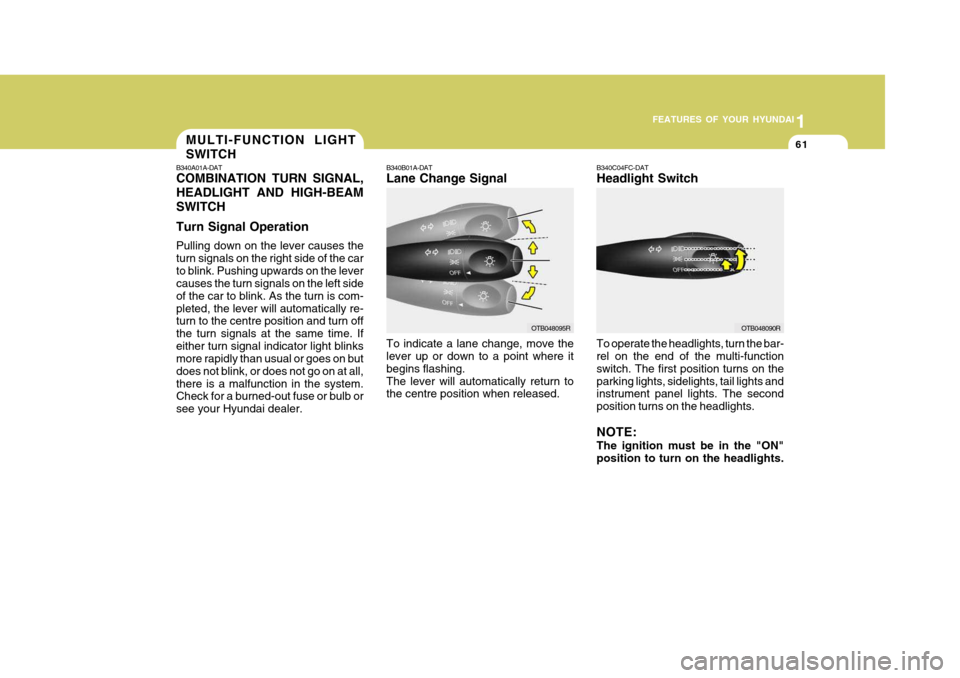
1
FEATURES OF YOUR HYUNDAI
61MULTI-FUNCTION LIGHT SWITCH
B340A01A-DAT COMBINATION TURN SIGNAL, HEADLIGHT AND HIGH-BEAMSWITCH Turn Signal Operation Pulling down on the lever causes the turn signals on the right side of the carto blink. Pushing upwards on the lever causes the turn signals on the left side of the car to blink. As the turn is com-pleted, the lever will automatically re- turn to the centre position and turn off the turn signals at the same time. Ifeither turn signal indicator light blinks more rapidly than usual or goes on but does not blink, or does not go on at all,there is a malfunction in the system. Check for a burned-out fuse or bulb or see your Hyundai dealer. B340B01A-DAT Lane Change Signal To indicate a lane change, move the lever up or down to a point where it begins flashing.The lever will automatically return to the centre position when released.
B340C04FC-DAT Headlight Switch To operate the headlights, turn the bar- rel on the end of the multi-function switch. The first position turns on theparking lights, sidelights, tail lights and instrument panel lights. The second position turns on the headlights. NOTE: The ignition must be in the "ON" position to turn on the headlights.
OTB048095ROTB048090R
Page 79 of 232
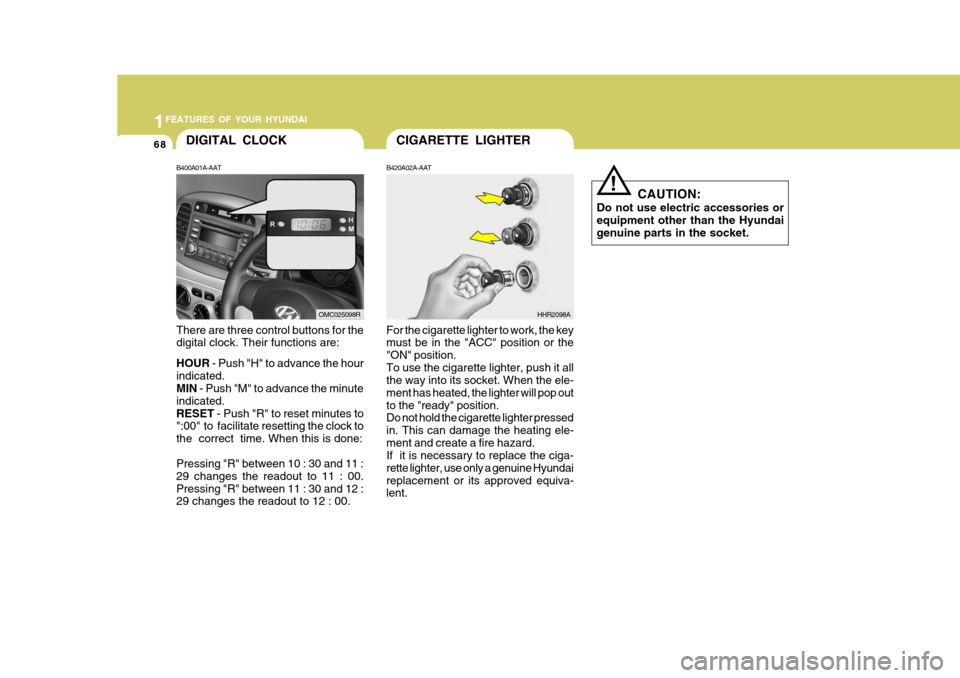
1FEATURES OF YOUR HYUNDAI
68CIGARETTE LIGHTERDIGITAL CLOCK
B420A02A-AAT For the cigarette lighter to work, the key must be in the "ACC" position or the "ON" position.To use the cigarette lighter, push it all the way into its socket. When the ele- ment has heated, the lighter will pop outto the "ready" position. Do not hold the cigarette lighter pressed in. This can damage the heating ele-ment and create a fire hazard. If it is necessary to replace the ciga- rette lighter, use only a genuine Hyundaireplacement or its approved equiva- lent.
B400A01A-AAT There are three control buttons for the digital clock. Their functions are: HOUR
- Push "H" to advance the hour
indicated. MIN - Push "M" to advance the minute
indicated. RESET - Push "R" to reset minutes to
":00" to facilitate resetting the clock tothe correct time. When this is done: Pressing "R" between 10 : 30 and 11 : 29 changes the readout to 11 : 00.Pressing "R" between 11 : 30 and 12 : 29 changes the readout to 12 : 00.
OMC025098RHHR2098A CAUTION:
Do not use electric accessories or equipment other than the Hyundaigenuine parts in the socket.
!
Page 129 of 232
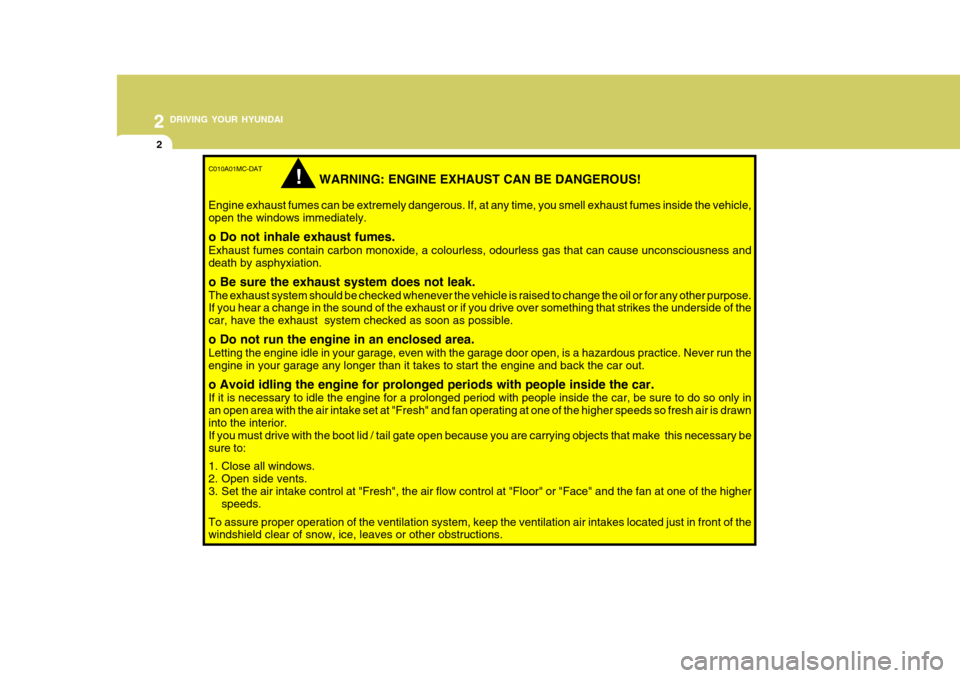
2 DRIVING YOUR HYUNDAI
2
C010A01MC-DAT
WARNING: ENGINE EXHAUST CAN BE DANGEROUS!
Engine exhaust fumes can be extremely dangerous. If, at any time, you smell exhaust fumes inside the vehicle, open the windows immediately. o Do not inhale exhaust fumes. Exhaust fumes contain carbon monoxide, a colourless, odourless gas that can cause unconsciousness and death by asphyxiation. o Be sure the exhaust system does not leak. The exhaust system should be checked whenever the vehicle is raised to change the oil or for any other purpose. If you hear a change in the sound of the exhaust or if you drive over something that strikes the underside of the car, have the exhaust system checked as soon as possible. o Do not run the engine in an enclosed area. Letting the engine idle in your garage, even with the garage door open, is a hazardous practice. Never run the engine in your garage any longer than it takes to start the engine and back the car out. o Avoid idling the engine for prolonged periods with people inside the car. If it is necessary to idle the engine for a prolonged period with people inside the car, be sure to do so only in an open area with the air intake set at "Fresh" and fan operating at one of the higher speeds so fresh air is drawninto the interior. If you must drive with the boot lid / tail gate open because you are carrying objects that make this necessary be sure to:
1. Close all windows.
2. Open side vents.
3. Set the air intake control at "Fresh", the air flow control at "Floor" or "Face" and the fan at one of the higher speeds.
To assure proper operation of the ventilation system, keep the ventilation air intakes located just in front of the windshield clear of snow, ice, leaves or other obstructions.
!
Page 151 of 232
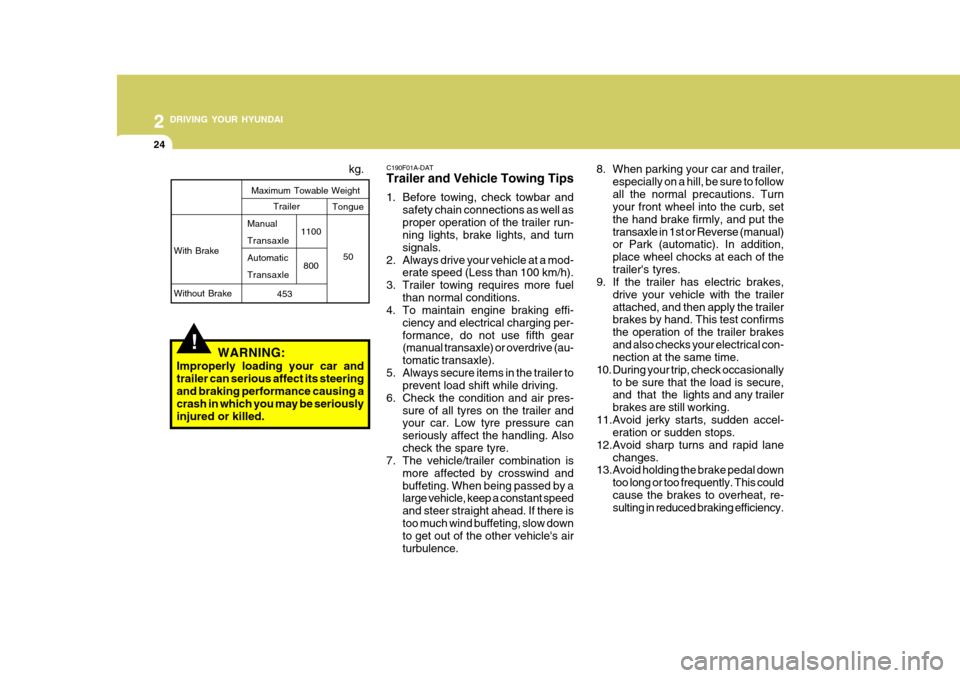
2 DRIVING YOUR HYUNDAI
24
8. When parking your car and trailer,especially on a hill, be sure to follow all the normal precautions. Turn your front wheel into the curb, set the hand brake firmly, and put thetransaxle in 1st or Reverse (manual) or Park (automatic). In addition, place wheel chocks at each of thetrailer's tyres.
9. If the trailer has electric brakes,
drive your vehicle with the trailerattached, and then apply the trailer brakes by hand. This test confirms the operation of the trailer brakesand also checks your electrical con- nection at the same time.
10. During your trip, check occasionally to be sure that the load is secure,and that the lights and any trailer brakes are still working.
11.Avoid jerky starts, sudden accel- eration or sudden stops.
12.Avoid sharp turns and rapid lane changes.
13.Avoid holding the brake pedal down
too long or too frequently. This couldcause the brakes to overheat, re- sulting in reduced braking efficiency.
!WARNING:
Improperly loading your car and trailer can serious affect its steeringand braking performance causing a crash in which you may be seriously injured or killed. kg.
With Brake Without Brake
Maximum Towable Weight
1100800
Trailer Tongue
50
453
Manual TransaxleAutomaticTransaxle C190F01A-DAT Trailer and Vehicle Towing Tips
1. Before towing, check towbar and
safety chain connections as well as proper operation of the trailer run- ning lights, brake lights, and turn signals.
2. Always drive your vehicle at a mod- erate speed (Less than 100 km/h).
3. Trailer towing requires more fuel than normal conditions.
4. To maintain engine braking effi-
ciency and electrical charging per-formance, do not use fifth gear (manual transaxle) or overdrive (au- tomatic transaxle).
5. Always secure items in the trailer to prevent load shift while driving.
6. Check the condition and air pres- sure of all tyres on the trailer and your car. Low tyre pressure can seriously affect the handling. Alsocheck the spare tyre.
7. The vehicle/trailer combination is
more affected by crosswind andbuffeting. When being passed by a large vehicle, keep a constant speed and steer straight ahead. If there istoo much wind buffeting, slow down to get out of the other vehicle's air turbulence.
Page 187 of 232
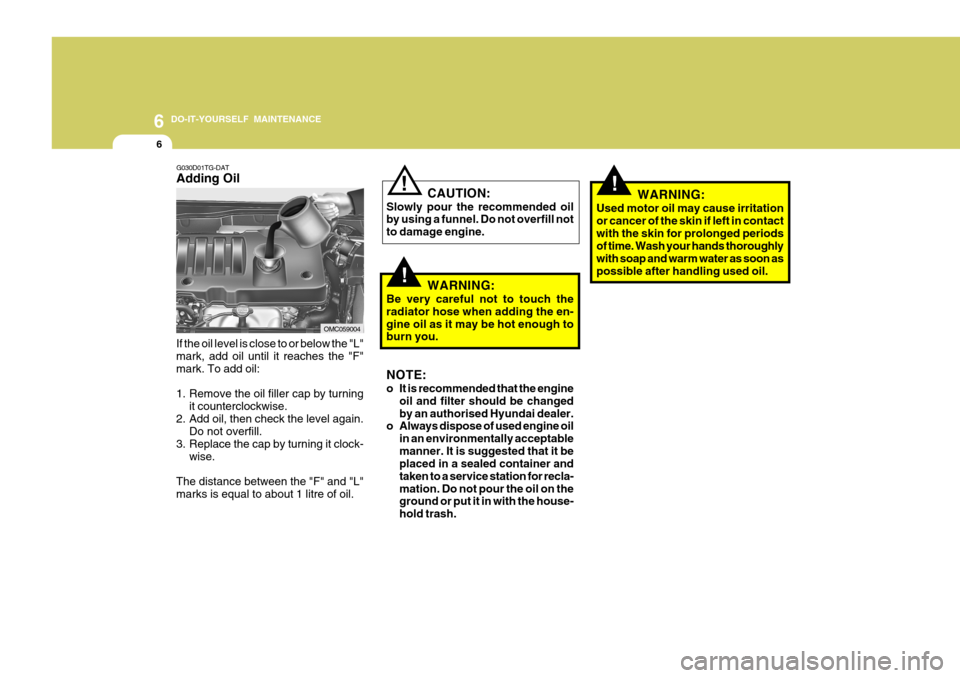
6 DO-IT-YOURSELF MAINTENANCE
6
!
!
!
CAUTION:
Slowly pour the recommended oil by using a funnel. Do not overfill not to damage engine.
WARNING:
Be very careful not to touch theradiator hose when adding the en-gine oil as it may be hot enough to burn you. NOTE:
o It is recommended that the engine oil and filter should be changed by an authorised Hyundai dealer.
o Always dispose of used engine oil
in an environmentally acceptablemanner. It is suggested that it be placed in a sealed container and taken to a service station for recla-mation. Do not pour the oil on the ground or put it in with the house- hold trash. WARNING:
Used motor oil may cause irritationor cancer of the skin if left in contactwith the skin for prolonged periods of time. Wash your hands thoroughly with soap and warm water as soon aspossible after handling used oil.
G030D01TG-DAT Adding Oil
If the oil level is close to or below the "L" mark, add oil until it reaches the "F" mark. To add oil:
1. Remove the oil filler cap by turning it counterclockwise.
2. Add oil, then check the level again. Do not overfill.
3. Replace the cap by turning it clock- wise.
The distance between the "F" and "L" marks is equal to about 1 litre of oil.
OMC059004
Page 222 of 232

8CONSUMER INFORMATION
6
!
I090A003MC-DAT WHEN TO REPLACE TYRES
The original tyres on your car have tread wear indicators. The location of tread wear indicators is shown by the"TWI" or "
" marks, etc., The tread
wear indicators appear when the tread depth is 1.6 mm (0.06 in). The tyreshould be replaced when these appear as a solid bar across two or more grooves of the tread. Always replaceyour tyres with those of the recom- mended size. If you change wheels, the new wheel's rim width and offset mustbe those specified by Hyundai. WARNING:
o Driving on worn-out tyres is dan- gerous! Worn-out tyres can causeloss of braking effectiveness, steering control and traction. When replacing tyres, never mix radialand bias-ply tyres on the same car. If you replace radial tyres with bias-ply tyres, they must be in-stalled in sets of four.
o Using tyres and wheels of other
than the recommended sizes maycause unusual handling charac- teristics that may cause death, serious injury or property dam-age.
o Tyres degrade over time, even when
they are not being used. Regard-less of the remaining tread, it is recommended that tyres generally be replaced after six (6) years ofnormal service. Heat caused by hot climates or frequent high loading conditions can accelerate the ag-ing process. Failure to follow this warning can result in sudden tyre failure, which could lead to a lossof control and an accident involv- ing serious injury or death.
OMC055017
Wear indicator
I070A01A-DAT TYRE BALANCING A tyre that is out of balance may affect handling and tyre wear. The tyres onyour Hyundai were balanced before the car was delivered but may need balancing again during the years youown the car. Whenever a tyre is dismounted for repair, it should be rebalanced beforebeing reinstalled on the car. I080A01A-DAT TYRE TRACTION Tyre traction can be reduced if you drive on worn tyres, tyres that are improperly inflated or on slippery roadsurfaces. Tyres should be replaced when tread wear indicators appear. To reduce the possibility of losing control,slow down whenever there is rain, snow or ice on the road.